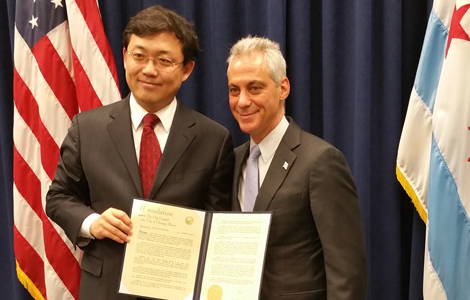Diversifying trade challenges China, Latin America: Analysts
Updated: 2015-02-02 05:11
By PAUL WELITZKIN in New York(China Daily Latin America)
|
||||||||
As China and Latin America vow to increase trade and investment, analysts said diversifying trade will be a challenge.
China and the Community of Latin American and Caribbean States (CELAC) released their cooperation plan on Jan 23 which calls for expanding trade between China and Latin America by $500 billion and increasing Chinese investment in Latin America by $250 billion over 10 years.
The trade and investment goals were introduced last month at the first China-CELAC ministerial meeting in Beijing, co-chaired by Chinese Foreign Minister Wang Yi and his Costa Rican counterpart Manuel Gonzalez Sanz. Also attending were the presidents of Costa Rica, Ecuador and Venezuela.
According to the International Monetary Fund, bilateral trade between China and Latin America has grown significantly since the early 2000s, from $12 billion in 2000 to $289 billion in 2013. The IMF noted that China is a more important trading partner for Latin America than the other way around. China is now the second largest source of Latin America’s imports (after the US) and the third largest destination of its exports (after the US and the European Union).
Many Latin American nations are eager to diversify the trade that is now heavily focused on commodities and sell more services and finished products to China.
The majority of trade between Latin America and China has and probably will continue to be focused on commodities, according to Kevin Gallagher, a professor of international relations at Boston University and co-director of the Global Economic Governance Initiative.
“Commodities are still what Latin America is all about,” he told China Daily. “However, there may be some room to open up that trade a bit more.”
Trade between China and Latin America is likely to become somewhat more diversified in the coming years, but will probably still be based on existing complementarities, said Margaret Myers of the Inter-American Dialogue (IAD), a Washington-based research group for policy analysis on issues in Western Hemisphere affairs.
"China is looking to Latin America and other regions to support certain domestic energy and food security objectives. The region’s commodities remain of considerable interest to Chinese firms and financiers,” she said.
Anton Edmunds is the president and CEO of Edmunds Group International, LLC, a strategic communications firm with offices in Washington and the Caribbean. He also sits on the board of the think tank Caribbean Policy & Research Center. He doesn’t believe Latin America will be able to take advantage of increased trade with China.
“Many in the region still look at China as a source for investment dollars in infrastructure rather than a viable market to export products,” he said in an e-mail to China Daily. He also said the region will have to conduct significant market research: “Very few Latin American companies have the resources and foresight to do this. Even more critical in terms of trade would be the establishment of a supply-chain mechanism that would get products to the Chinese market in a timely fashion.”
Beatrice Rangel, president and CEO of AMLA Consulting in Miami Beach, Florida, is not so pessimistic. “My guess is that over the next five years commodities will continue to have the upper hand. But eventually trade composition will change as China begins to export parts and intermediate products to be assembled somewhere in Mexico, Central America and the Caribbean. Also Mexico and Brazil will start penetrating the Chinese market for consumer goods. But that trend will take hold later in the decade,” she said in an e-mail.
Rangel served as a chief of staff and minister of the secretariat during the presidency of Carlos Andres Perez of Venezuela.
Will the slowing Chinese economy prevent China and Latin America from reaching these ambitious goals? “Trade should continue to increase in the coming years as China and Latin American countries reduce certain trade barriers and as China looks to expert higher-value goods to the region,” said Myers.
Boston University’s Gallagher said he hopes that Latin America will take advantage of this increased trade if it comes to fruition. “This will not save Latin America as Latin America must save itself. And the best way to do that is to invest more into education and infrastructure,” he said.
paulwelitzkin@chinadailyusa.com
Most Viewed
Editor's Picks

|

|

|

|

|

|
Today's Top News
Jan manufacturing PMI falls to 28-month low
Central China city allows 72-hour visa exemptions
Beijing to build Universal Studios
Head of China Minsheng Bank resigns
78% of China's luxury spending done overseas
Mexico suspends high-speed train project
Alibaba may face class-action suit
MH370 verdict reached
US Weekly

|

|















